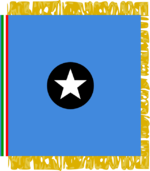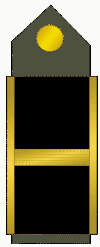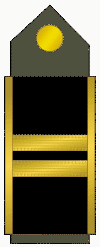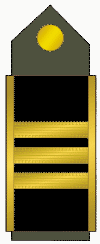Somali Gendarmerie (Italian Empire)
The Gendarmerie of Somalia (Somali: Gandarmaariiga ee Soomaaliya; Arabic: الدرك من الصومال, al Ddarak min al Ssumal; Italian: Gendarmeria della Somalia) is the national gendarmerie force and the law enforcement agency of the Autonomous Social Republic of Somalia. As with most other police forces in the world, its duties include crime fighting (including the enforcement of the Xeer), traffic control, maintaining public security, and counter-terrorism. It is under the jurisdiction of the Minister of Interior, Directorate-General of Public Security.
The Gendarmerie serves as one of the principal organs of the Somali Government. While organised at a national level, each arm reports to a Regional police authority, which in turn divides its force by local Police Divisions, headquartered at local police stations. In an emergency, the Gendarmerie can be reached by dialing 888 from any telephone in Somalia. With regard to the relationship with other entities, the Somali Gendarmerie accepts local self policing: clan-based Militia units act against theft and low-level violence and urban-based neighbourhood watch schemes of the Militia provide reassurance and support to the Somali Gendarmerie.
Contents
History
The Gendarmerie of Somalia was formally established on 1 December 1960, following the dissolution of the Italian African Police; the newly established Somali Police Corps inherited about 1,200 Somali policemen and 800 Italian policemen. Shortly afterwards, the Gendarmerie absorbed the Carabinieri Higher Command Somalia on 1 February 1962. In order to strengthen the military character of the new organisation, the Somali Police Corps was renamed Somali Gendarmerie on 1 June 1968.
After a transitional phase, Schools and other facilities were established by 1967 (Subofficers School in 1958, Officers School in 1964). The first commander was former P.A.I. Colonel Graziano Funari, and all officers were Italians or Italian Somalis until 1972.
Starting from the mid-1970s, the corps pursued a moderate "somalization" policy in order to enable indigenous Officers to take command and senior management, also because the ongoing debate in Italy wether the former colonies had to be disbanded or not. The first Somali commander was Colonel Jaamac Qoorsheel, who held command from 1976 to 1979. Nevertheless, Italian Somali presence has remained significant through the years.
In the 1993 Somali Crisis saw the Somali Gendarmerie was not directly involved in the fightings but for mobile units and for its intelligence activities. Thanks to a combined action of Gendarmerie and Italian units Mohamed Farrah Aidid was captured.
Organisation
Officers and agents of the Somali Gendarmerie depend on their superiors. For institutional services the Corps Commands depend on government authorities having jurisdiction over the area where they are located. Those authorities, except in extraordinary cases, only turn to commanders who then give nocessarie provisions.
The Gendarmerie manages a type of recruitment characterised as "intertribal" with a double physiognomy of territorial organisation (Stations and Fixed Police posts), with integrated mobile Units that if necessary act in favour of nomads, also interposing in the clashes between them for grounds for grazing and exploitation of springs.
The organisation of the Gendarmerie follows both the demographics of Somalia and the administrative divisions. Broadly speaking, the Gendarmerie has a Territorial Organisation, a Mobile Organisation (for riot control and armed services) and a Training Organisation; some specialist units are directly attached to the General Command. The organisation is closely modelled on the Carabinieri structure, with further adaptations in order to deal with scarce population density and arising security needs.
Police Schools are all based in Mogadiscio. There are training courses dedicated to officers, inspectors and subofficers, while newly recruited troops are trained at their Group Commands; there are also technical validation courses for subofficers and specialization courses.
A military atmosphere prevails - dress codes, behavior standards, and rank differentiations are strictly adhered to. Esprit de corps is inculcated with regular ceremonies and institutionalization of rituals such as applauding personnel dispatched to or returning from assignments and formally welcoming senior officers to the mess hall at all meals.
General Command
At its top, the Gendarmerie has the General Command, based in Mogadishu, led by a Commander (a Major General), who is assisted by a Deputy Commander and a Chief of Staff (both Brigadier Generals). The Deputy Commander leads the Specialist Units Command, which consists of:
- Integrated Investigative Office;
- Tributary Police Group;
- Anti-drug Police Group;
- Banditry Police Office (tasked with investigative work in supporting mobile forces);
- Specialised Stock Theft Prevention Unit;
- Special Research Office;
- Counter-Terrorism Unit;
- Judicial and Political Database;
- Port Police Office (mainly in charge for ports of Mogadiscio, Bender Cassim, Brava, Berbera, Chisimaio, Gibuti and Merca where it has dedicated Groups);
- Traffic Police Office (Gadidka Poliska);
- Communications and Support Office;
- Border Control Unit;
- General and National Administrative Affairs Group;
The Custodial Command, Health Service, the Logistics Service and the Personnel Service depend on the Chief of Staff.
Territorial organisation
The Somali Gendarmerie is organised in State and Region boundaries, in order to provide response to the diverse needs.
Multiregional Command
The Somali Gendarmerie has a dedicated Multiregional Command for each Constituent State and Federal Territory of the Somali Autonomous Social Federal Republic. These seven multi-regional boundaries exist for security and tactical planning purposes.
Each State issues its own interpretation of the Xeer and different groups may issue their own official position; each Regional Command may be required by the Constituent State authorities to enforce a duly issued Xeer sentence. Each State also provides the general administration to the relevant territory; each Multiregional Command has an administrative police structure.
Regional Gendarmerie Group
For central administrative purposes, Somalia is divided into 19 Regions (Gobollada, singular Gobol), which in turn are subdivided into Districts. In each Region there is a Gendarmerie Group, commanded by a Lieutenant Colonel or, for most populated Regions, by a Colonel. Each Group has a Command, some Companies (at least one per District) and several Stations and Posts. Within Groups and Companies, both information and investigative squads and teams operate in the territories. In order to provide investigations in Xeer-related legal cases, each Gendarmerie Group maintains a dedicated unit. The Xeer Policing Unit consists of specialised detectives (Gurtiyal) to investigate cases and of uniformed agents (Waranle) to enforce the customary law.
Strength of Regional Gendarmerie Groups varies according to the needs. The Gibuti Group has around 1,500 Gendarmes, augmented by the 5th Battalion of the 2nd Gendarmerie Regiment (600 troops ca.); on the converse, the Mogadishu Federal Territory Multiregional Command, which coincides with the Benadir Gendarmerie Group, has 4,500 Gendarmes, augmented by the 1st Battalion of the 1st Gendarmerie Regiment (600 troops ca.).
Regional Commission of Public Order and Public Security
Within each Regional Command, it exists a Regional Commission of Public Order and Public Security (Somali: Gudiga Gobolka ee Amarka Dadweynaha iyo Amniga Dadweynaha). The Regional Commission has the task to develop, according government's guidelines, a community safety and security plan.
The Commission includes the Regional Governor, the Gendarmerie Commander, the Somali National Militia Regional commander and elements from social groups existing in the Region: District and Municipal authorities, Somali Fascist Party leaders, clan elders and religious leaders, representatives of Italians, Corporations, women and youths. Clan elders and representatives of sensitive categories are recruited according to clan-based rules.
Urban security
In larger cities, a whole Somali Gendarmerie Company is usually deployed. In such cases, a Company exists for the urban area and another Company for the remainder of the relevant District. The Gendarmerie carries out both uniformed presence and investigations work. In case of necessity, the Gendarmerie uses the local Militia Command, which in turn sets up local watch groups. The Militia local watch groups also use their ties to the Gendarmerie to involve them quickly in cases of violent encounters with criminals. This is officially presented as an implementation of the concept of Fascist Corporatism.
While the Somali Gendarmerie may need a temporary reinforcement in periods when Mobile Forces are not immediately available or risk to be too visible on the streets, and therefore relies on the Somali National Militia, the Militia local watch groups, in turn, cannot enforce the law and rely on the police if they encounter criminal gangs or witness a serious crime such as murder. Police and Militia thus complement each other in the provision of local security. It is to note that, in all cases, the local watch groups are under the aegis of the Somali National Militia and, on the other hand, the Somali Gendarmerie regulates and controls their patrolling activities.
Mobile forces
The Mobile organisation is a mobile group used to keep peace between unresting clans in the interior. The first iteration of the mobile force consisted of the Mobile Border Nucleus (Nucleo Mobile di Frontiera), a Battalion with the task of guarding the Somali-Ethiopian and the Somali-Kenyan borders based in Belet Uen, and of the Celere Police Unit (Reparto Celere di Polizia), based in Mogadiscio. Both units were established back in 1950s, and existed until 1968.
Nowadays, the force (Birmadka Poliska) is structured as two large Regiments with a total of ten Mobile Battalions. The 1st Gendarmerie Regiment, which inherited traditions from the Celere Police Unit, has its headquarters in Mogadiscio, while individual Battalions are based in Mogadiscio, Belet Uen, Chismaio, Merca and Obbia; the 2nd Gendarmerie Regiment, successor of the Mobile Border Nucleus, is based in Rocca Littorio (also known as Gallicaio), while individual Battalions are based in Rocca Littorio, Bosaso, Berbera, Borama and Gibuti. Tasks entrusted to the Mobile Battalions are riot control, maintenance of public order and security and counter-insurgency.
In addition, an autonomous Helicopter Squadrons Group, directly dependent on the General Command, is based in Garoe. In order to deal with rough terrain, sparse and semi-nomadic populations and security needs, four autonomous Long Range Patrol Companies (named Darawishta Poliska after the Dervish movement) are set up in Iscia Baidoa and in Rocca Littorio and are also available for military needs as well as a source for detachments tasked with protecting important organisations.
While Darawishta Poliska members attend a six-month tactical training course, Birmadka personnel receive training in public order and riot control.
Personnel and training
Since the early 1960s, Gendarmerie recruits have to be seventeen to twenty-five years of age, of high moral caliber, and physically fit. All training activities are framed and coordinated by the Training Command.
After the recruits complete this service, the Gendarmerie could request renewal of their contracts. Officer cadets underwent a two-years long training course that emphasize supervision of police field performance. Subofficers and Officers are also politically motivated.
Training Command
The Training Command, based in Mogadiscio, is the body in charge for troops and officers training and professional development. It consits of:
- Commander
- Staff;
- Security Consultative Commission;
- Officers Development School (Mogadiscio);
- Cadet Subofficers School (Iscia Badoa);
- Cadet Gendarmes Schools (Mogadiscio and Chismaio).
Security Consultive Commission
In order to coordinate and synchronize police training activities and other professional development related activities provided to the Somali Gendarmerie, the Security Consultive Commission is a consultive body serving as a permanent board for the coordination and synchronization of police training activities. The Commission is also entitled to certify, review or audit police training activities. The Security Consultive Commission is chaired by the Commander, Training Command. Members of the development board include 10 delegates from the Somali Gendarmerie and 4 representatives from the Regia Guardia di Finanza and the Royal Carabinieri.
Issues
The functioning of the Somali Gendarmerie is seen as problematic, especially regarding corruption, clan-based favouritism, lack of impartiality, and human rights violations.
Small arms within the general population
Recent investigations on small arms availability in Somalia indicates that some 70 per cent of households own small arms, about 73 per cent of which are assault rifles. While the public display of guns is not tolerated and is rarely seen in urban areas, and although a gun registration system exists, Somali society continues to be heavily armed.
Ranks and Inisgnia
The Somali Gendarmerie is led by a Brigadier General; when the General-Inspector of the Militarized Police Corps or the Chief of Police conduct their inspections and visits, he wears his Italian uniform. From a graphic point of view, the officer insignia pattern are loosely inspired to the Italian trend, with the Italian Towered Crown (symbol of the Itaian State) being replaced by the Somalian seal.
All officer rank insignia feature the Star insignia as basic component. As a whole, the Somali Gendarmerie is a State military corps, like the Royal Police Corps or the Royal Carabinieri, and is part of the Italian military system, although its State is Somalia within the Italian Empire, and not the Kingdom of Italy strictu sensu.
A common feature for all ranks is the round cap emblem, featuring the Latin wording "GAANDARMARIIGA - WAX DAN AH KAMA".

















